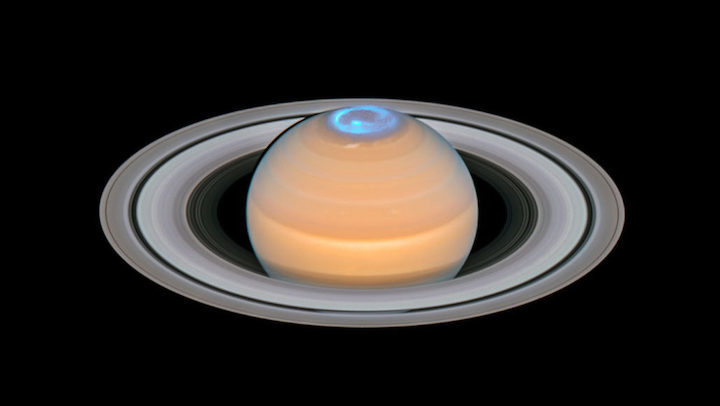7.04.2020

Saturn’s northern aurora (shown glowing in ultraviolet light this composite image from the Hubble Space Telescope) and its southern counterpart could warm the planet’s upper atmosphere.
Saturn’s auroras may heat its atmosphere like an electric toaster.
Measurements from NASA’s Cassini spacecraft’s final orbits show that Saturn’s upper atmosphere is hottest where its auroras shine, a finding that could help solve a long-standing mystery about the outer planets.
Saturn’s upper atmosphere is much hotter than scientists first expected based on the planet’s distance from the sun. In fact, all the gas giant planets — Saturn, Jupiter, Uranus and Neptune — were thought to have chilly upper atmospheres of around 150 kelvins (–123° Celsius). But data from the Voyager spacecraft, which flew past the outer planets in the 1970s and 1980s (SN: 8/7/17), showed surprisingly toasty upper atmospheres of 400 to 600 kelvins (125° to 325° C).
Planetary scientists dub this mismatch an “energy crisis.” Something injects extra energy into the gas giants’ atmospheres, but no one knew what. “Trying to explain why these temperatures are so high has long been a goal in planetary atmospheric physics,” says planetary scientist Ron Vervack of Johns Hopkins University’s Applied Physics Laboratory.
Data from the Cassini spacecraft’s waning weeks might point to an answer, planetary scientist Zarah Brown of the University of Arizona in Tucson and colleagues report April 6 in Nature Astronomy.
After orbiting Saturn for 13 years, Cassini finished its mission with a daredevil series of dips between the planet and its rings before plunging into Saturn’s atmosphere in September 2017 (SN: 9/15/17). During those final orbits, the spacecraft probed the planet’s upper atmosphere by watching stars in the background. Measuring the amount of starlight that the atmosphere blocks told Brown and colleagues how dense the atmosphere is at different points, a clue to its temperatures.
Using 30 of these stellar measurements, 22 of which came from the last six weeks of Cassini’s mission, the team mapped Saturn’s atmospheric temperatures across the whole planet and at different depths. “For the outer planets, this is an unprecedented data set,” says planetary scientist Tommi Koskinen, also of the University of Arizona.
The atmosphere was hottest around 60° N and 60° S latitudes — roughly where Saturn’s glowing auroras show up (SN: 2/16/05). Auroras are brilliant lights that sparkle when charged particles from the sun interact with a planet’s magnetosphere, the region defined by a planet’s magnetic field. Unlike Earth’s visible auroras, Saturn’s auroras glow mainly in ultraviolet light.
The auroras’ light doesn’t emit much heat on its own, but is accompanied by electric currents that can generate heat like the wires in a toaster. This process, called Joule heating, also happens in Earth’s atmosphere.
If Jupiter, Uranus and Neptune’s auroras also coincide with extra heat, then auroras may solve the mystery of hot atmospheres across the solar system. The same process could even take place on exoplanets, Brown says.
Vervack, who has worked with the Voyager dataset but was not involved in the new work, thinks this study marks “a big step in our understanding” of these hot upper atmospheres.
“The real test of whether they’re right will be when you go out to Uranus or Neptune,” whose magnetospheres are more complicated than Saturn’s, he says. “Being able to see how our understanding from Saturn holds up when we get to these more complicated systems is going to be really key to knowing if we’ve licked this problem or not.”
Quelle: ScienceNews
